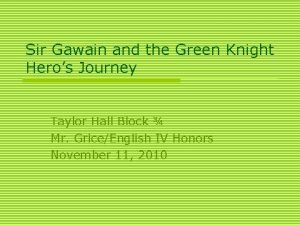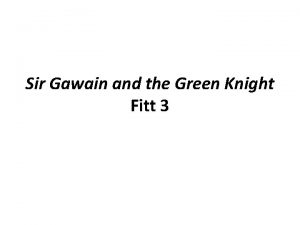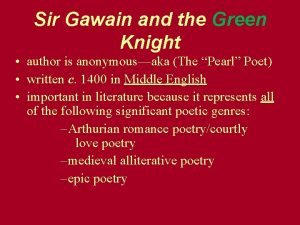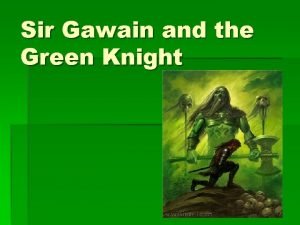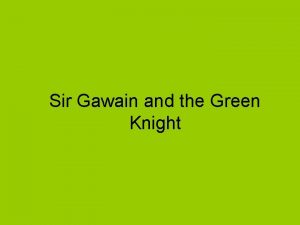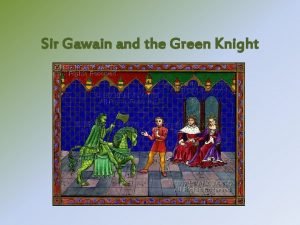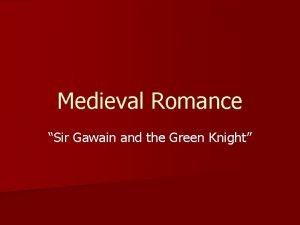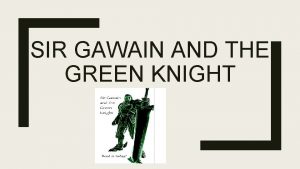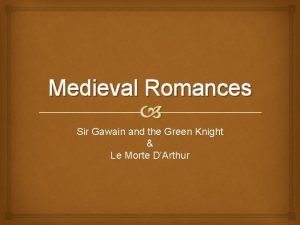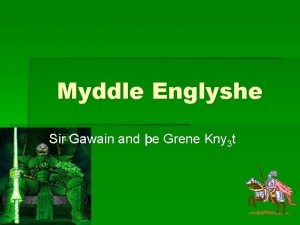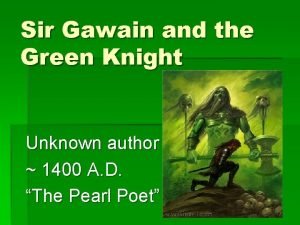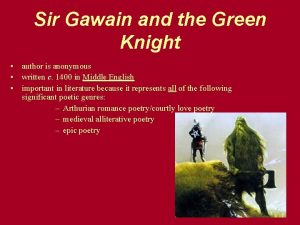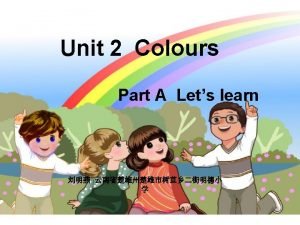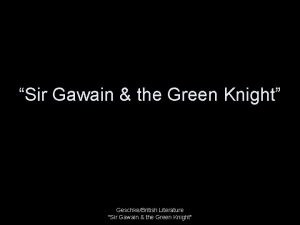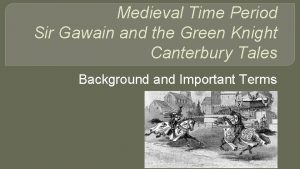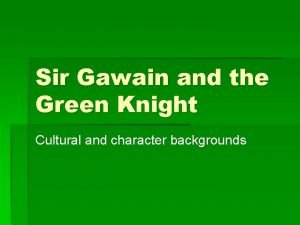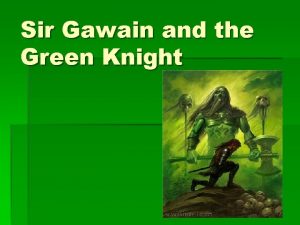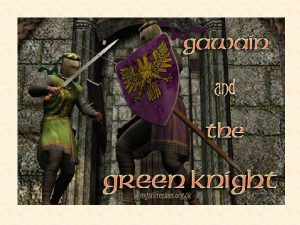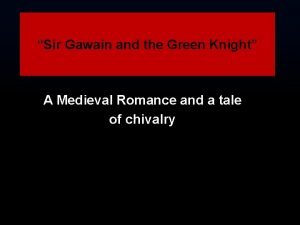Identifying Time in Sir Gawain and the Green


















- Slides: 18

“Identifying” Time in Sir Gawain and the Green Knight Caroline Barta

Surfaces “Sir Gawain and the Green Knight is a poem so devoted to the surfaces of things (its lavish attention to courtly manners, occasions, and appointments is often remarked) and so preoccupied with keeping the depths and fissures from bursting forth (its narrative swerve from beheading to confession and penance is the most pointed example) that it labors to limit the significance of its signs, the nature of its characters, the meanings of their actions” (Dinshaw 205).

Time’s relation to Cohen’s Identity Romance “Sir Gawain and the Green Knight performs the fullest, most complex euhemerization of the giant, completely rewriting the gigantomachia at the heart of identity romance…Sir Gawain was composed toward the close of the fourteenth century of romance. Yet the poem locates its action in romance’s green season” (Cohen 144).

Picture of Gawain beheading the Green Knight from the Gawain manuscript. Particularly look at colors and sizes of figures. What do you see?

Lady Bertilak tempting Gawain in his bedchamb er

Third Gawain Illustration. Second Confrontation between Gawain and the Green Knight.

Final Gawain Illustration. Depicts Gawain’s return to court.

Temporal Divisions I propose essentially three main temporal divisions within Gawain. 1. Seasonal – Following both the symbolic associations and agricultural implications of the annual period of Gawain’s quest, the four seasons color the episodes of the poem. 2. Liturgical – Narrated by symbolic resonances within the Christian year, the festivals of fasting, feasting, and various Saint’s Days further subdivide the solar year. 3. Mythic – Bookended by references to Trojan / Roman / Early Briton “history, ” calendrical time fades into the

Symbolic Seasons • Spring (Birth / Infancy /Childhood) -- The coming of the vernal season signified new life, youth, and above all, hope. • Summer (Virulent Manhood)– Along with spring, summer was known as a “time of ease and rest, ” and, often, romance. • Autumn (Middle Age--Aged) – The harvest having been brought in (in the liminal time between summer and autumn), autumn represents a time of transition, waning, and uncertainty. • Winter (Aged—Death) – The cold harshness of winter drives people inside, and, although broken slightly by the merriment of Christmas and New Year, this season dwelled in darkness.

Seasonal transition section in the original manuscript

Gawain’s Liturgy (the Calendar) v. New Year’s Day, January 1 (Feast of the Circumcision) v. Lent (40 days before Easter) v[Easter /Probable Pentecost (lunar)] v. Michaelmas, September 29 th v. All Saint’s Day, November 1 v. Advent (four weeks prior to Christmas) v. Christmas Eve, December 24 v. St. John’s Day, December 27

Gawain’s Liturgy (the Calendar) Omitted or assumed liturgical dates we expect, but are not expressly mentioned v. Easter v. Pentecost v. St. John’s (the Baptist) Day – Midsummer’s Day, June 24 th v. Martinmas (November 11) v. Advent


Why the Trojan bookends? • The poem begins and ends with references to Troy. But why? • Vergil’s imperially funded and supervised Aeneid essentially remythologized the Greek’s most significant “historical” win (and proposed Roman ancestral loss) into a “glorious” origin story for the powerful Roman empire. Given the Trojan bookends of this story, is “remythologizing” the Arthur story the purpose of the Gawain poet? But if so, what loss, embarrassment, or later development does he wish to transform from loss into ultimate victory?

Further questions… An autumnal narrative engrossed by vernal days gone by, Gawain reads as a narrative preoccupied with nostalgia for the past—either because of the perceived simplicity of youth, or because, by considering the past in a new light (c. f. previous consideration of Vergil), one may see setbacks or trials as actual victories. What purpose does nostalgia serve in this narrative?

Further questions… While Gawain presents itself as a more pious romance than we have seen, some curiosities still exist. Why does Gawain omit (except by inference) notice of Easter and Pentecost? This seems particularly significant, since these days feature heavily in other romances emphasizing time passing and the process of maturity in a knight (c. f. Chretien’s Perceval)?

Further questions… Does the temporal structuralism of the narrative parallel Gawain’s own process of identity formation? I’m thinking here of Cohen’s use of the term euhemerization, description of identity romance, and the types of temporal structuralism I’ve outlined (seasonal, liturgical, mythic). Does Gawain grow or change— essentially, does he become more of a person, less an actor in a mythological role?

Final page from the Gawain manuscript
 Hero's journey sir gawain and the green knight
Hero's journey sir gawain and the green knight Sir gawain and the green knight fitt 3
Sir gawain and the green knight fitt 3 Sir gawain's shield
Sir gawain's shield Who is the antagonist in sir gawain and the green knight
Who is the antagonist in sir gawain and the green knight Is sir gawain and the green knight a medieval romance
Is sir gawain and the green knight a medieval romance Sir gawain and the green knight genre
Sir gawain and the green knight genre Sir gawain and the green knight vocabulary
Sir gawain and the green knight vocabulary Bob and wheel sir gawain
Bob and wheel sir gawain Read the excerpts from sir gawain and the green knight
Read the excerpts from sir gawain and the green knight Bercilak de hautdesert
Bercilak de hautdesert Sir gawain medieval romance
Sir gawain medieval romance Sir gawain and the green knight hero's journey
Sir gawain and the green knight hero's journey Adjective
Adjective Non identifying adjective clauses examples
Non identifying adjective clauses examples Identifying and non identifying adjective clauses
Identifying and non identifying adjective clauses Ioun pronunciation
Ioun pronunciation Sir gawain author
Sir gawain author Sir gawain author
Sir gawain author Yellow light
Yellow light
